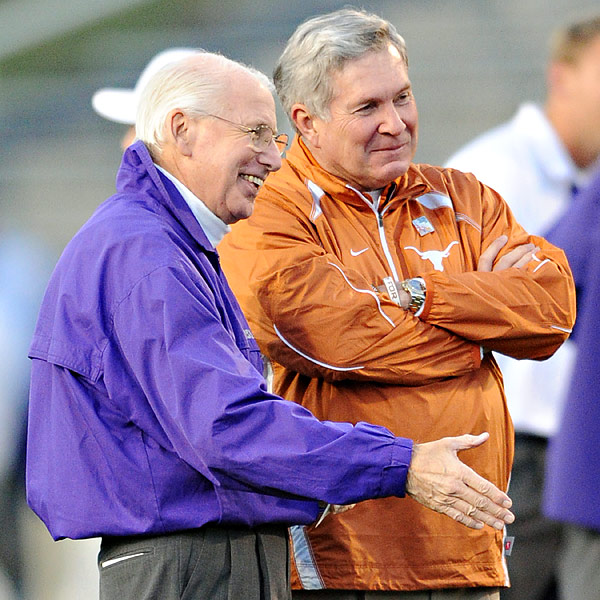Among my 10+ boring predictions for 2011 I divined that Andrew Luck would win the Heisman, the BCS title game would feature two relative newcomers, and Bo Pelini's head would literally explode. With that endorsement:
1) Alabama will beat Georgia to win the SEC. Unclear on their conference memberships, the WAC and Big East will also name Alabama their conference champion. The WAC and Big East will then merge to form the Big Athletic Conference. This will only compound the conference membership problem. By the end of the decade, Conference USA will be the only truly regional conference in America.
2) Teams in the Sun Belt and MAC will play games against each other. Their mothers will be able to verify this. Ohio will win a lot of games. We will pretend to care so we can present ourselves as truly erudite college football fans.
 |
| "Coach, it's not me, it's you. You're terrible" |
3) Washington St will be better than Texas Tech (and Maryland). West Virginia (and Michigan) will be better than Arizona (and Oklahoma St), and I will find out why we aren’t all making fun of Coach Holgorsen’s hair. Ohio St will be better than Florida. USC will be better than the Seattle Seahawks. Alabama will be better than LSU (and Michigan, but not better than the Falcons). Texas A&M this season will be much better than in 2011, but not better than the Dolphins. Wisconsin will win 12 games with a quarterback discarded by a 2-10 team. Connecticut and Maryland will both be terrible (much worse than, say, Vanderbilt). And someone at the worldwide leader will wonder aloud why some struggling program hasn’t snatched up Rick Neuheisel yet. This means something. This is important.
 |
| "Mack, did you try to negotiate an extension?" |
4) Texas will again lose four or more games* despite giving up fewer than 17 points per game. Oklahoma will be the class of the Big XII but will lose to Kansas to fall out of national title contention. Kansas St will lose 6 games by 10 total points after Bill Snyder’s deal with the devil expires. Tuberville will plead with Snyder for the devil’s digits only to learn that Tech has a long standing arrangement that involves locking players in equipment sheds. [*I keep predicting this and it keeps coming true.]
5) Wisconsin will win their conference championship. Three Badgers will rush for over 1,000 yards and Danny O’Brien will set himself up as a Heisman contender in 2013. I am still boycotting the divisions established by that particular conference and, therefore, refuse to comment on who Wisconsin will beat in the championship game. But I will say that it will not be Penn St. In the confusion of conference realignment we will mistake Indiana, Purdue and Northwestern for B1G teams, but after watching them play at home we will remember they belong in the MAC.
6) Kenjon Barner will rush for 1,500 yards, but Matt Barkley will throw for 15,000 and win the Heisman. USC will beat Washington (and be better than Tennessee . . . that doesn't mean anything) to win the Pac-5,6,8,10,12. We will find out that Stanford was more than Andrew Luck; it was Jim Harbaugh and the fading remnants of his pixie dust. And even Harbaugh in the flesh wasn’t enough to beat Oregon.
 |
| "I will love you, Coach Edsall" |
7) Florida St will NOT win the ACC. I don’t know who will win the ACC, and I don’t really care, but it WON’T be Florida St. Florida St will be 9-4. Next season we will all be amazed at the talent they have along the defensive line and we will put them in the top 10. In 2013, Florida St will not win the ACC. Nor will Maryland. Instead of firing Edsall, Maryland will punish Edsall by dropping its football program and reassigning Edsall to coach the new mens synchronized swimming team. Maryland fans will want to know if this will help them beat Duke in basketball. It will not.
8) Boise St will remind us that, even after losing 7 players to the draft, the better program beats Georgia by 14, not in triple overtime. Like Alabama, Boise St will claim 3 conference championships, but will do it by playing in three different conferences over the course of the season. The other teams in its conferences will also play games, and some of those games will be very entertaining, I’m sure.
 |
| Don't worry kids, this one doesn't count |
9) It will slowly dawn on the football community that we ignored one of the best pre-bowl seasons in college football history, a head-to-head match-up and conference standings so we could crown a champion based on one game played a month after the season had ended, and that we responded to this by changing the rules to put more emphasis on these pseudo, post-season games. We will recognize that we have been duped by the major sports media into believing that this is what we want . We will then pay for their insider access and log on to their forums so we can read about and discuss the sad state of college football.
 |
| With no Sam Cunningham on the USC roster, Bama wins 24-17 |
10) Alabama will beat USC by 7 in the national championship game, and somehow we will twist this into meaning that the 7 terrible teams in the SEC are not terrible, that games ending 3-2 mean that your conference is good at football, and that a non-SEC team that tried to play a season in the SEC and had to play many of these 7 terrible teams would be murdered in the process because an SEC schedule is so brutal. We would think this even though last year the SEC East champ got a beatdown by the second best team in the MWC, and all statistical evidence shows that the SEC is only marginally better than the other elite conferences, and that the other elite conferences are, in fact, deeper. And I will rejoice in this now that my team is in the SEC.
 But we can do better than that. If we assign a point value to field position, down, distance and time remaining in the half, we can directly measure the point impact of a turnover. By that method, fumbles cost 3.49 points on average and interceptions 3.35 points. Given that one turnover advantage every ten games, that comes out to .359 points per game.
But we can do better than that. If we assign a point value to field position, down, distance and time remaining in the half, we can directly measure the point impact of a turnover. By that method, fumbles cost 3.49 points on average and interceptions 3.35 points. Given that one turnover advantage every ten games, that comes out to .359 points per game.























